14 Lecture 5 Exercises
This tutorial was created by John Santos (with minor adaptations from me).
14.1 How to (nicely) display model results
If we want to display models in a more aesthetically-pleasing format than with the summary() command, we have a few options.
Let’s start by running some models.
library(wooldridge)
data("wage1")
wage_mod1<- lm(wage ~ educ + exper, data=wage1)
wage_mod1a<- lm(I(wage*100) ~ educ + exper, data=wage1)
wage_mod2 <- lm(wage ~ educ, data=wage1)
14.1.1 The boring, ugly way (Base R)
summary(wage_mod1)##
## Call:
## lm(formula = wage ~ educ + exper, data = wage1)
##
## Residuals:
## Min 1Q Median 3Q Max
## -5.5532 -1.9801 -0.7071 1.2030 15.8370
##
## Coefficients:
## Estimate Std. Error t value Pr(>|t|)
## (Intercept) -3.39054 0.76657 -4.423 1.18e-05 ***
## educ 0.64427 0.05381 11.974 < 2e-16 ***
## exper 0.07010 0.01098 6.385 3.78e-10 ***
## ---
## Signif. codes: 0 '***' 0.001 '**' 0.01 '*' 0.05 '.' 0.1 ' ' 1
##
## Residual standard error: 3.257 on 523 degrees of freedom
## Multiple R-squared: 0.2252, Adjusted R-squared: 0.2222
## F-statistic: 75.99 on 2 and 523 DF, p-value: < 2.2e-16summary(wage_mod1a)##
## Call:
## lm(formula = I(wage * 100) ~ educ + exper, data = wage1)
##
## Residuals:
## Min 1Q Median 3Q Max
## -555.32 -198.01 -70.71 120.30 1583.70
##
## Coefficients:
## Estimate Std. Error t value Pr(>|t|)
## (Intercept) -339.054 76.657 -4.423 1.18e-05 ***
## educ 64.427 5.381 11.974 < 2e-16 ***
## exper 7.010 1.098 6.385 3.78e-10 ***
## ---
## Signif. codes: 0 '***' 0.001 '**' 0.01 '*' 0.05 '.' 0.1 ' ' 1
##
## Residual standard error: 325.7 on 523 degrees of freedom
## Multiple R-squared: 0.2252, Adjusted R-squared: 0.2222
## F-statistic: 75.99 on 2 and 523 DF, p-value: < 2.2e-16summary(wage_mod2)##
## Call:
## lm(formula = wage ~ educ, data = wage1)
##
## Residuals:
## Min 1Q Median 3Q Max
## -5.3396 -2.1501 -0.9674 1.1921 16.6085
##
## Coefficients:
## Estimate Std. Error t value Pr(>|t|)
## (Intercept) -0.90485 0.68497 -1.321 0.187
## educ 0.54136 0.05325 10.167 <2e-16 ***
## ---
## Signif. codes: 0 '***' 0.001 '**' 0.01 '*' 0.05 '.' 0.1 ' ' 1
##
## Residual standard error: 3.378 on 524 degrees of freedom
## Multiple R-squared: 0.1648, Adjusted R-squared: 0.1632
## F-statistic: 103.4 on 1 and 524 DF, p-value: < 2.2e-16
14.1.2 {stargazer}
The easiest is to use the {stargazer} package and its eponymously-named function. This package is easy enough, flexible enough, but, unfortunately, no longer maintained.
library(stargazer)##
## Please cite as:## Hlavac, Marek (2022). stargazer: Well-Formatted Regression and Summary Statistics Tables.## R package version 5.2.3. https://CRAN.R-project.org/package=stargazerstargazer(wage_mod1, wage_mod1a, wage_mod2,
title = "Modeling wage versus education and experience",
type = "text")##
## Modeling wage versus education and experience
## ============================================================================================
## Dependent variable:
## ------------------------------------------------------------------------
## wage I(wage * 100) wage
## (1) (2) (3)
## --------------------------------------------------------------------------------------------
## educ 0.644*** 64.427*** 0.541***
## (0.054) (5.381) (0.053)
##
## exper 0.070*** 7.010***
## (0.011) (1.098)
##
## Constant -3.391*** -339.054*** -0.905
## (0.767) (76.657) (0.685)
##
## --------------------------------------------------------------------------------------------
## Observations 526 526 526
## R2 0.225 0.225 0.165
## Adjusted R2 0.222 0.222 0.163
## Residual Std. Error 3.257 (df = 523) 325.704 (df = 523) 3.378 (df = 524)
## F Statistic 75.990*** (df = 2; 523) 75.990*** (df = 2; 523) 103.363*** (df = 1; 524)
## ============================================================================================
## Note: *p<0.1; **p<0.05; ***p<0.01For {stargazer}, you want to set the type= option to “text” while you work in RStudio, but change it to “html” or “latex” when you output your final document (respectively, as an HTML file or .tex file).
14.1.3 {modelsummary}
We can also use the package modelsummary and its function msummary(). This package is a little more involved, but produces a more flexible output, works with a wider variety of models, and is actively maintained.
## `modelsummary` 2.0.0 now uses `tinytable` as its default table-drawing backend. Learn more at:
## https://vincentarelbundock.github.io/tinytable/
##
## Revert to `kableExtra` for one session:
##
## options(modelsummary_factory_default = 'kableExtra')
## options(modelsummary_factory_latex = 'kableExtra')
## options(modelsummary_factory_html = 'kableExtra')
##
## Silence this message forever:
##
## config_modelsummary(startup_message = FALSE)##
## Attaching package: 'modelsummary'## The following object is masked from 'package:psych':
##
## SDmsummary(models = dvnames(list(wage_mod1, wage_mod1a, wage_mod2)),
statistic = c("std.error", "p.value"),
stars = TRUE,
title = "Modeling wage versus education and experience",
notes = "Cell entries are parameter estimates, standard errors, and p values")| wage | I(wage * 100) | wage | |
|---|---|---|---|
| + p | |||
| Cell entries are parameter estimates, standard errors, and p values | |||
| (Intercept) | -3.391*** | -339.054*** | -0.905 |
| (0.767) | (76.657) | (0.685) | |
| ( | ( | (0.187) | |
| educ | 0.644*** | 64.427*** | 0.541*** |
| (0.054) | (5.381) | (0.053) | |
| ( | ( | ( | |
| exper | 0.070*** | 7.010*** | |
| (0.011) | (1.098) | ||
| ( | ( | ||
| Num.Obs. | 526 | 526 | 526 |
| R2 | 0.225 | 0.225 | 0.165 |
| R2 Adj. | 0.222 | 0.222 | 0.163 |
| AIC | 2739.9 | 7584.6 | 2777.4 |
| BIC | 2757.0 | 7601.6 | 2790.2 |
| Log.Lik. | -1365.969 | -3788.288 | -1385.712 |
| F | 75.990 | 75.990 | 103.363 |
| RMSE | 3.25 | 324.77 | 3.37 |
14.2 Functional form
14.2.1 Feelings towards the LPC (quadratics)
Quadratics on the right-hand-side (RHS) of a regression equation are useful for capturing non-linear relationships, especially when that relationship is non-monotonic.
When a function is non-monotonic, it means that it switches direction (either positive to negative or negative to positive).
We’ll demonstrate this by modelling feelings towards the Liberal Party of Canada and market liberalism.
## Min. 1st Qu. Median Mean 3rd Qu. Max. NA's
## 0.00 6.00 9.00 8.59 11.00 16.00 32684summary(ces$feel_lib)## Min. 1st Qu. Median Mean 3rd Qu. Max. NA's
## 0.00 16.00 54.00 48.34 77.00 100.00 2640ggplot(ces) +
aes(x = feel_lib, y = marketlib) +
geom_point(position = "jitter") +
geom_smooth(method = "lm") +
geom_smooth(method = "lm",
formula = "y ~ x + I(x^2)",
color = "red")## `geom_smooth()` using formula = 'y ~ x'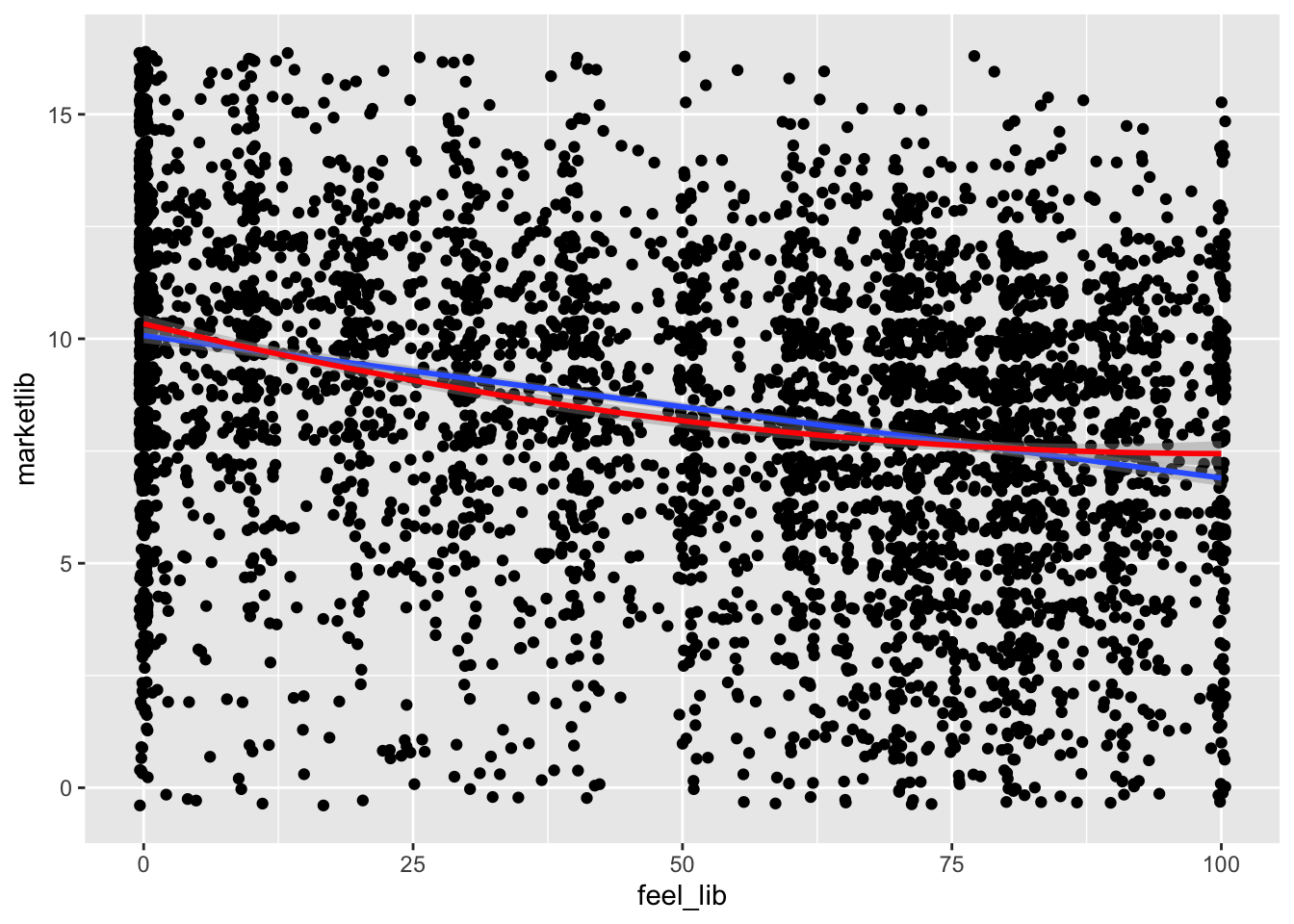
feel1 <- lm(feel_lib ~ marketlib, data = ces)
feel2 <- lm(feel_lib ~ marketlib + I(marketlib^2), data = ces)
stargazer(feel1, feel2,
type = "text")##
## =======================================================================
## Dependent variable:
## ---------------------------------------------------
## feel_lib
## (1) (2)
## -----------------------------------------------------------------------
## marketlib -2.802*** 0.654
## (0.130) (0.481)
##
## I(marketlib2) -0.216***
## (0.029)
##
## Constant 71.472*** 60.439***
## (1.203) (1.904)
##
## -----------------------------------------------------------------------
## Observations 4,781 4,781
## R2 0.089 0.099
## Adjusted R2 0.089 0.099
## Residual Std. Error 31.808 (df = 4779) 31.628 (df = 4778)
## F Statistic 466.091*** (df = 1; 4779) 263.454*** (df = 2; 4778)
## =======================================================================
## Note: *p<0.1; **p<0.05; ***p<0.01The effect of X on Y, or of marketlib on feel_lib requires both
The above has a convenient approximation of
14.2.1.1 Calculating the turning point of a quadratic
The point (at least theoretically) at which a quadratic function changes direction is called the turning point, or the inflection point, or a functional minimum/maximum. It is often represented as
Another way to think about this is the point at which the rate of change of Y across values of X equals 0, or more formally
For quadratic equations of
For the example above, this point is
So, the turning point at which a one-unit change in marketlib causes feelings towards the LPC to change direction is -1.5. This is outside of the actual range of the marketlib variable, so it is of no relevance to us (hence why the turning point is sometimes only theoretical).
You’ll encounter this later in the course, so don’t worry about this too much at this point.
14.2.2 Occupational prestige (logarithms)
Logarithms are useful on both the right- (predictor) and left-hand-side (outcome) of regression equations.
The log of
It can also be useful in the converse situation.
## education income women prestige census type
## Min. : 6.380 Min. : 611 Min. : 0.000 Min. :14.80 Min. :1113 bc :44
## 1st Qu.: 8.445 1st Qu.: 4106 1st Qu.: 3.592 1st Qu.:35.23 1st Qu.:3120 prof:31
## Median :10.540 Median : 5930 Median :13.600 Median :43.60 Median :5135 wc :23
## Mean :10.738 Mean : 6798 Mean :28.979 Mean :46.83 Mean :5402 NA's: 4
## 3rd Qu.:12.648 3rd Qu.: 8187 3rd Qu.:52.203 3rd Qu.:59.27 3rd Qu.:8312
## Max. :15.970 Max. :25879 Max. :97.510 Max. :87.20 Max. :9517ggplot(Prestige) +
aes(x = income, y = prestige) +
geom_point(position = "jitter") +
geom_smooth(method = "lm") +
labs(title = "prestige ~ income")## `geom_smooth()` using formula = 'y ~ x'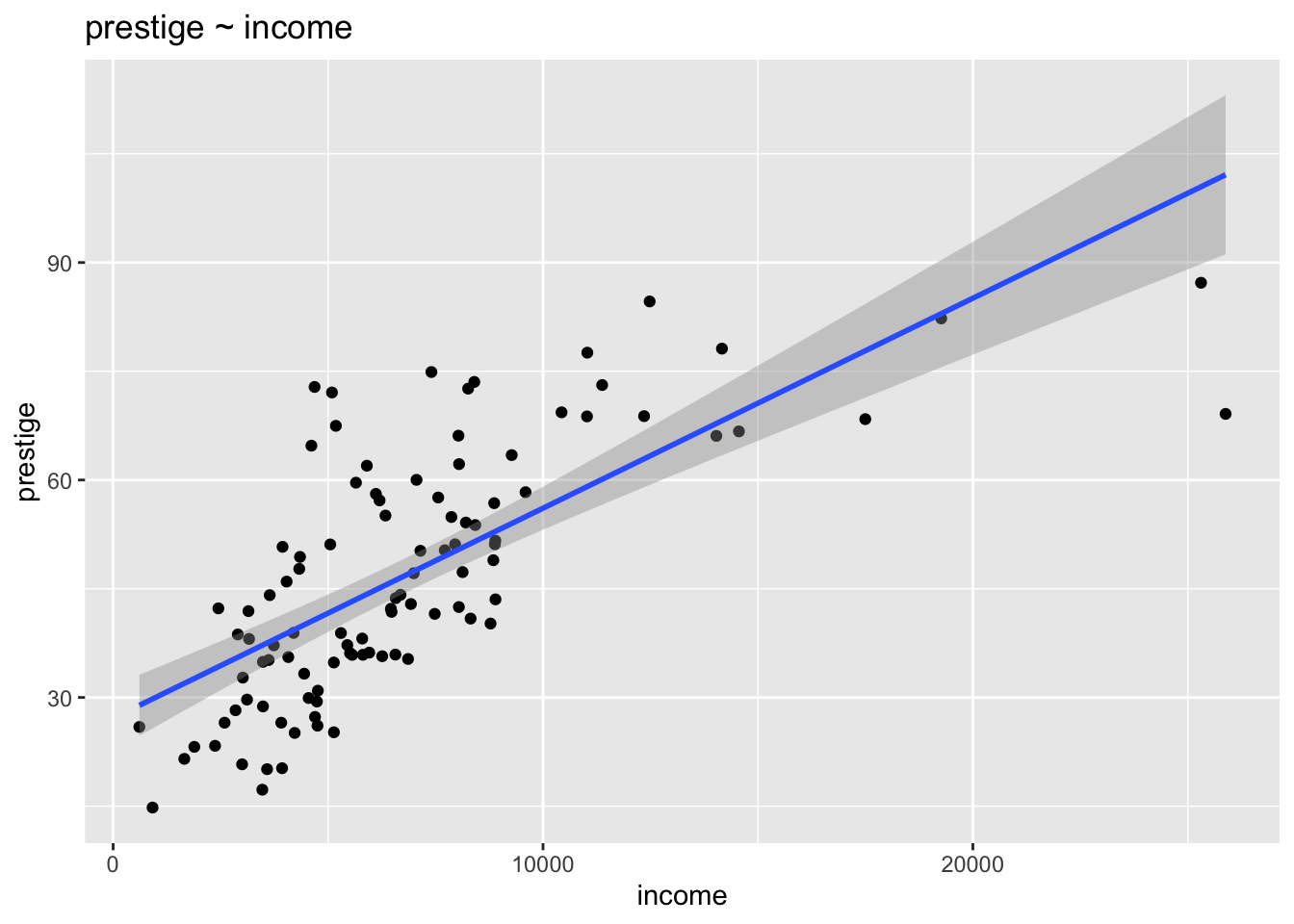
##
## Call:
## lm(formula = prestige ~ income, data = Prestige)
##
## Residuals:
## Min 1Q Median 3Q Max
## -33.007 -8.378 -2.378 8.432 32.084
##
## Coefficients:
## Estimate Std. Error t value Pr(>|t|)
## (Intercept) 2.714e+01 2.268e+00 11.97 <2e-16 ***
## income 2.897e-03 2.833e-04 10.22 <2e-16 ***
## ---
## Signif. codes: 0 '***' 0.001 '**' 0.01 '*' 0.05 '.' 0.1 ' ' 1
##
## Residual standard error: 12.09 on 100 degrees of freedom
## Multiple R-squared: 0.5111, Adjusted R-squared: 0.5062
## F-statistic: 104.5 on 1 and 100 DF, p-value: < 2.2e-16For every increase in income of $1, prestige increases by about 0.002897 points on a scale from 14 to 87 points.
Alternatively, for every increase in $1000, prestige increases by about 2.9 points (0.002897 * 1000 = 2.897).
BUT…, is the relationship actually linear?
ggplot(Prestige) +
aes(x = income, y = prestige) +
geom_point(position = "jitter") +
geom_smooth(method = "lm") +
geom_smooth(method = "lm", formula = "y ~ log(x)", color = "red") +
labs(title = "prestige ~ income")## `geom_smooth()` using formula = 'y ~ x'
It looks like a logarithmic function might work better, so let’s try that.
To make the coefficients easier to interpret, we’ll make a new variable that is a transformation of income, but measured in thousands.
Prestige$income1000 <- Prestige$income / 1000
prest1 <- lm(prestige ~ income1000, data = Prestige)
prest2 <- lm(prestige ~ log(income1000), data = Prestige)
prest3 <- lm(log(prestige) ~ income1000, data = Prestige)
prest4 <- lm(log(prestige) ~ log(income1000), data = Prestige)
library(stargazer)
stargazer(prest1, prest2, prest3, prest4,
type = "text")##
## =========================================================================
## Dependent variable:
## ------------------------------------------
## prestige log(prestige)
## (1) (2) (3) (4)
## -------------------------------------------------------------------------
## income1000 2.897*** 0.062***
## (0.283) (0.007)
##
## log(income1000) 21.556*** 0.499***
## (1.953) (0.044)
##
## Constant 27.141*** 9.050** 3.353*** 2.901***
## (2.268) (3.611) (0.055) (0.081)
##
## -------------------------------------------------------------------------
## Observations 102 102 102 102
## R2 0.511 0.549 0.452 0.566
## Adjusted R2 0.506 0.545 0.447 0.562
## Residual Std. Error (df = 100) 12.090 11.609 0.291 0.259
## F Statistic (df = 1; 100) 104.537*** 121.810*** 82.642*** 130.520***
## =========================================================================
## Note: *p<0.1; **p<0.05; ***p<0.01Remembering our rules for interpreting models, which are…
- level-level A unit increase in X results in a b unit increase in Y
- level-log A percent increase in X results in a (b/100)*unit increase in Y
- log-level A unit increase in X results in a 100*b% increase in Y
- log-log A percent increase in X results in a b% increase in Y
Therefore, the interpretation of each equation is as follows:
- For every increase in income of $1 (thousand), prestige increases by about 2.897 points.
- For every 1% increase in income (in thousands), prestige increases by .21556 points (i.e.
ˆβ1/100=21.556/100== - For every increase in income of $1 (thousand), prestige increases 6.2% (i.e.
- For every 1% increase in income (in thousands), prestige increases by 0.499%.
p1 <- ggplot(Prestige) +
aes(x = income, y = prestige) +
geom_point(position = "jitter") +
geom_smooth(method = "lm") +
labs(title = "prestige ~ income")
p2 <- ggplot(Prestige) +
aes(x = log(income), y = prestige) +
geom_point(position = "jitter") +
geom_smooth(method = "lm") +
labs(title = "prestige ~ log(income)")
p3 <- ggplot(Prestige) +
aes(x = income, y = log(prestige)) +
geom_point(position = "jitter") +
geom_smooth(method = "lm") +
labs(title = "log(prestige) ~ income")
p4 <- ggplot(Prestige) +
aes(x = log(income), y = log(prestige)) +
geom_point(position = "jitter") +
geom_smooth(method = "lm") +
labs(title = "log(prestige) ~ log(income)")
library(ggpubr)##
## Attaching package: 'ggpubr'## The following objects are masked from 'package:tidylog':
##
## group_by, mutateggarrange(p1, p2, p3, p4)## `geom_smooth()` using formula = 'y ~ x'## `geom_smooth()` using formula = 'y ~ x'
## `geom_smooth()` using formula = 'y ~ x'
## `geom_smooth()` using formula = 'y ~ x'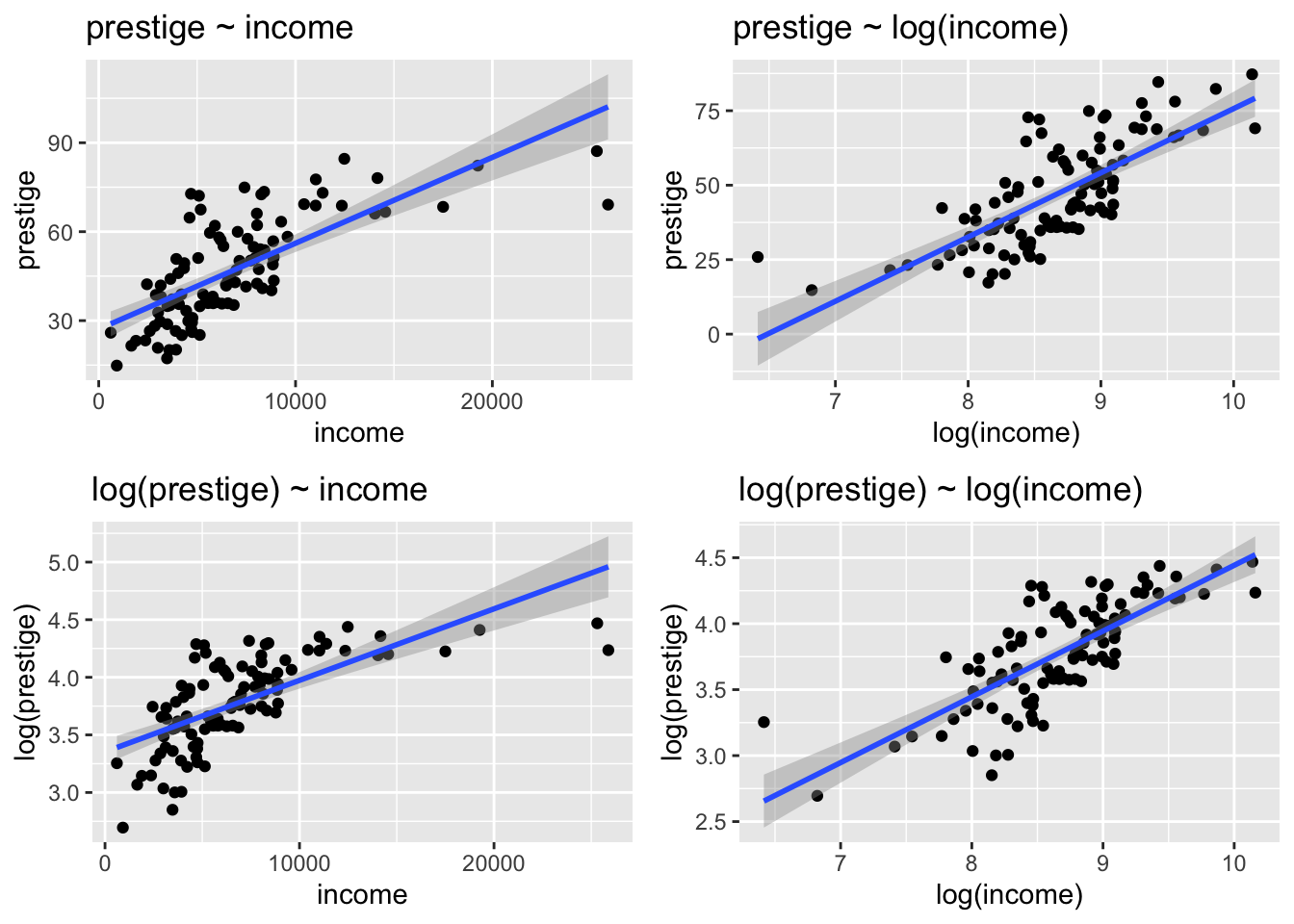
14.2.3 Automobile performance (logarithms)
This is another exercise using the the mtcars dataset from the carData package. We’ll model quarter-mile time (qsec) as a function of horsepower (hp).
## mpg cyl disp hp drat wt qsec
## Min. :10.40 Min. :4.000 Min. : 71.1 Min. : 52.0 Min. :2.760 Min. :1.513 Min. :14.50
## 1st Qu.:15.43 1st Qu.:4.000 1st Qu.:120.8 1st Qu.: 96.5 1st Qu.:3.080 1st Qu.:2.581 1st Qu.:16.89
## Median :19.20 Median :6.000 Median :196.3 Median :123.0 Median :3.695 Median :3.325 Median :17.71
## Mean :20.09 Mean :6.188 Mean :230.7 Mean :146.7 Mean :3.597 Mean :3.217 Mean :17.85
## 3rd Qu.:22.80 3rd Qu.:8.000 3rd Qu.:326.0 3rd Qu.:180.0 3rd Qu.:3.920 3rd Qu.:3.610 3rd Qu.:18.90
## Max. :33.90 Max. :8.000 Max. :472.0 Max. :335.0 Max. :4.930 Max. :5.424 Max. :22.90
## vs am gear carb
## Min. :0.0000 Min. :0.0000 Min. :3.000 Min. :1.000
## 1st Qu.:0.0000 1st Qu.:0.0000 1st Qu.:3.000 1st Qu.:2.000
## Median :0.0000 Median :0.0000 Median :4.000 Median :2.000
## Mean :0.4375 Mean :0.4062 Mean :3.688 Mean :2.812
## 3rd Qu.:1.0000 3rd Qu.:1.0000 3rd Qu.:4.000 3rd Qu.:4.000
## Max. :1.0000 Max. :1.0000 Max. :5.000 Max. :8.000hpqsec1 <- lm(qsec ~ hp, data = mtcars)
hpqsec2 <- lm(qsec ~ log(hp), data = mtcars)
hpqsec3 <- lm(log(qsec) ~ hp, data = mtcars)
hpqsec4 <- lm(log(qsec) ~ log(hp), data = mtcars)
library(stargazer)
stargazer(hpqsec1, hpqsec2, hpqsec3, hpqsec4,
type = "text")##
## =====================================================================
## Dependent variable:
## ---------------------------------------
## qsec log(qsec)
## (1) (2) (3) (4)
## ---------------------------------------------------------------------
## hp -0.018*** -0.001***
## (0.003) (0.0002)
##
## log(hp) -2.576*** -0.146***
## (0.500) (0.027)
##
## Constant 20.556*** 30.422*** 3.032*** 3.591***
## (0.542) (2.453) (0.029) (0.134)
##
## ---------------------------------------------------------------------
## Observations 32 32 32 32
## R2 0.502 0.469 0.530 0.488
## Adjusted R2 0.485 0.451 0.515 0.471
## Residual Std. Error (df = 30) 1.282 1.323 0.069 0.072
## F Statistic (df = 1; 30) 30.190*** 26.514*** 33.882*** 28.575***
## =====================================================================
## Note: *p<0.1; **p<0.05; ***p<0.01ggplot(mtcars) +
aes(x = hp, y = qsec) +
geom_point(position = "jitter") +
geom_smooth(method = "lm") +
geom_smooth(method = "lm", formula = y ~ log(x), color = "red") +
labs(title = "qsec ~ hp")## `geom_smooth()` using formula = 'y ~ x'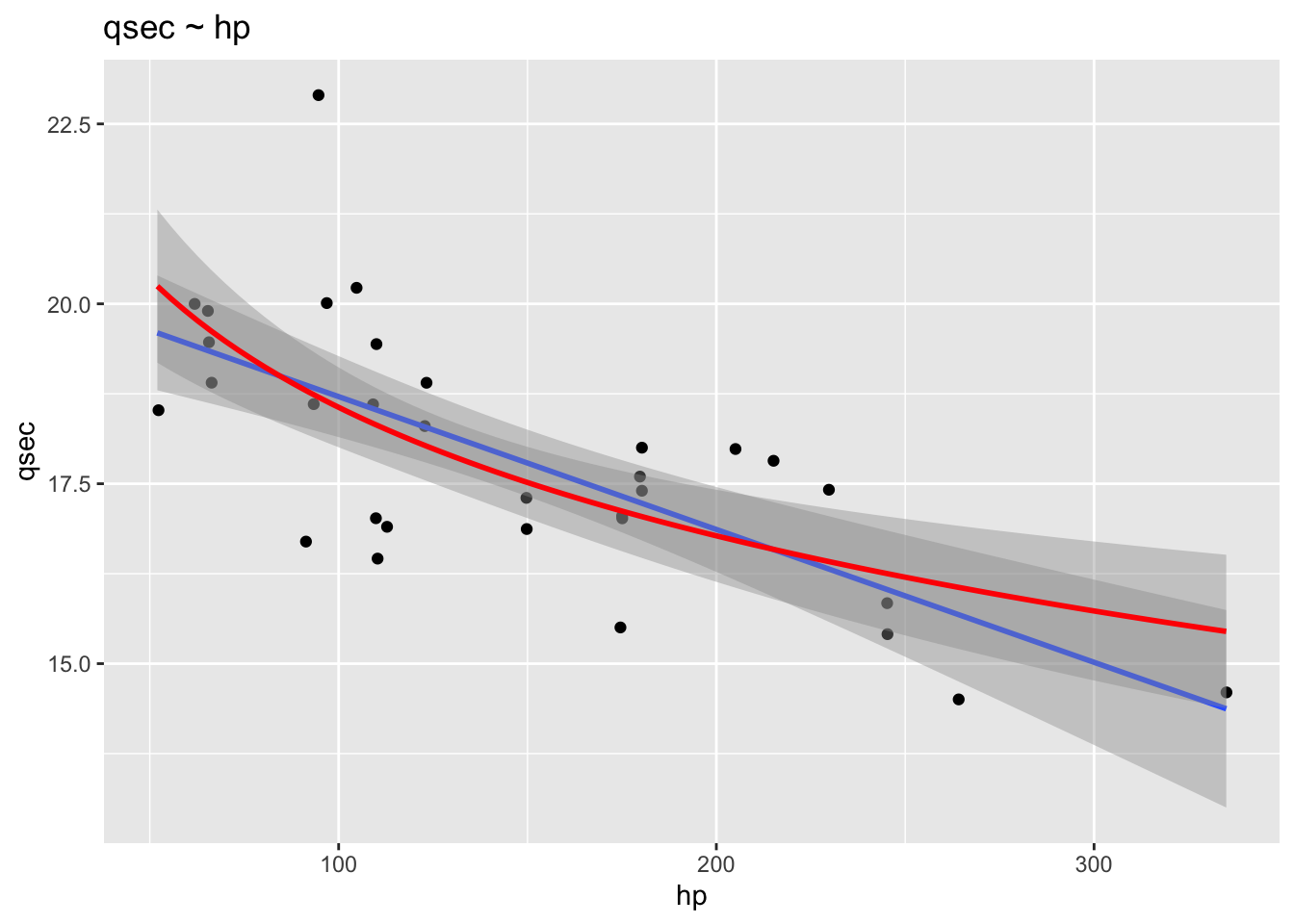
ggplot(mtcars) +
aes(x = hp, y = log(qsec)) +
geom_point(position = "jitter") +
geom_smooth(method = "lm", formula = y ~ x) +
labs(title = "log(qsec) ~ hp")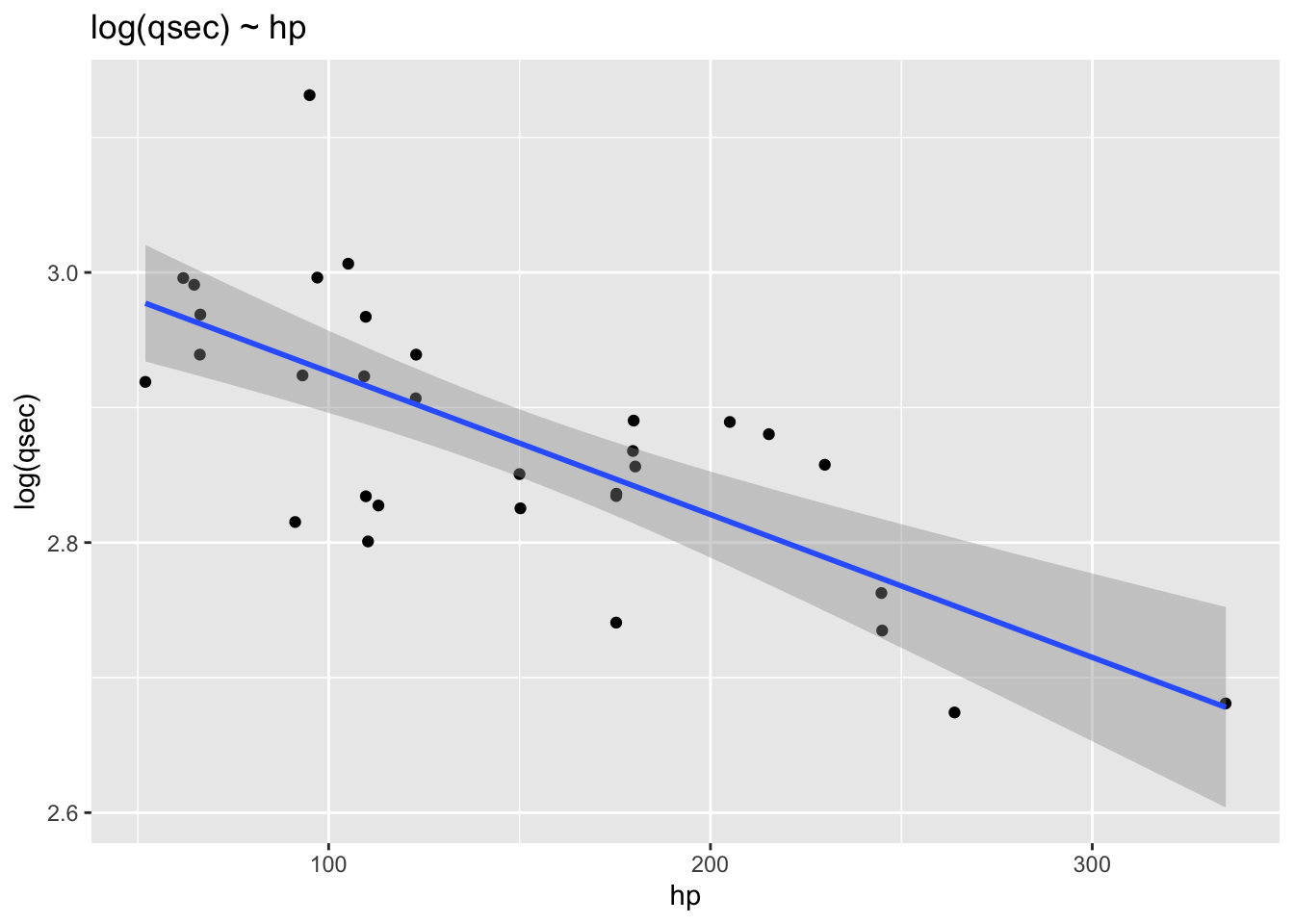
ggplot(mtcars) +
aes(x = log(hp), y = log(qsec)) +
geom_point(position = "jitter") +
geom_smooth(method = "lm", formula = y ~ x) +
labs(title = "log(qsec) ~ log(hp)")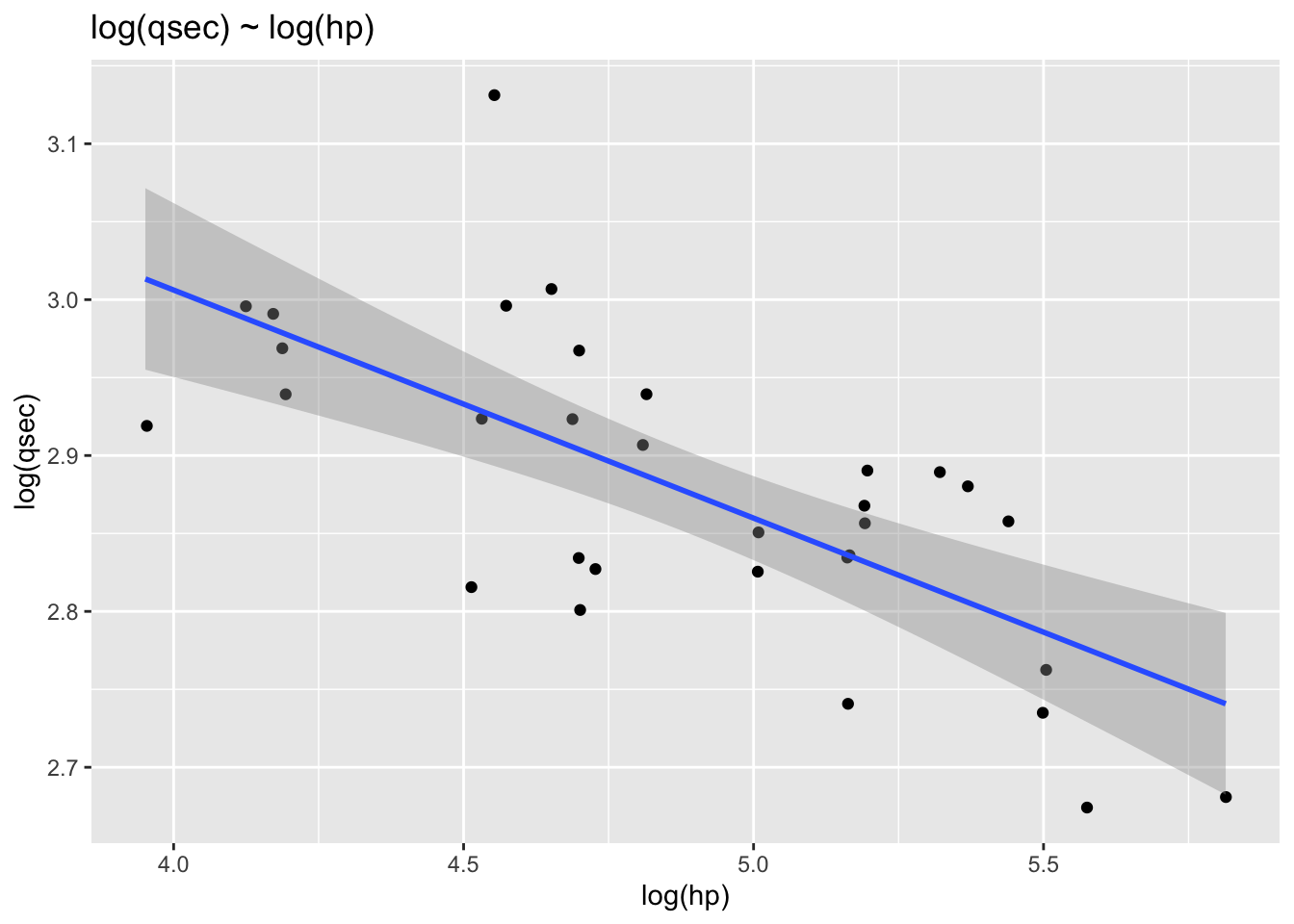
14.3 Practice exercises
From lecture:
Using the ‘fertil2’ dataset from ‘wooldridge’ on women living in the Republic of Botswana in 1988…
- Estimate the regression equation of the number of children on education, age of the mother, and electricity.
- Interpret
- Verify that sample covariance between predicted values and residuals = 0.
- Verify that sample covariance between education and residuals = 0.
- Re-estimate the regression equation of the number of children on education, age of the mother, and electricity but also include the square of the age of the mother. How do you now interpret the effect of age on the number of children?
Using the ‘wage1’ datadest from ‘woolridge’ on US workers in 1976…
- Estimate the regression equation of the hourly wage (wage) in dollars on education (educ) and experience (exper).
- How do the coefficients change when the units of wages are in cents instead of dollars?
- Compare the estimated coefficient for education to the one obtained by regressing only the hourly wage on education. Interpret.
Additional exercises for tutorial:
There’s an old saying (often attributed to Winston Churchill) that goes, “If you are not a liberal when you are young, you have no heart. If you are not a conservative when you are old, you have no brain.” And, yet there have been activist left-wing groups comprised of seniors, like the Raging Grannies.
Using our sample CES dataset, explore the relationship between Canadians’ support for free market principles (
14.4 STOP!!
Before you continue, try solving the exercises on your own. It’s the only way you will learn. Then, come back to this page and see how well you did.
14.6 Lecture exercises
14.6.1 Q1. Estimate the regression equation of the number of children on education, age of the mother, and electricity.
Before I begin, I’m going to make a data frame that only contains the variables I need and then listiwise delete all NAs. This will make it easier to run the diagnostic tests.
library(wooldridge)
library(tidyverse)
data("fertil2")
dat <- fertil2 %>%
select(c(children, educ, age, electric)) %>%
na.omit()## select: dropped 23 variables (mnthborn, yearborn, radio, tv, bicycle, …)Our population model is:
library(wooldridge)
fertil2 <- get(data('fertil2'))
library(dplyr)
fmod1 <- lm(children ~ educ + age + electric, data = dat)
summary(fmod1)##
## Call:
## lm(formula = children ~ educ + age + electric, data = dat)
##
## Residuals:
## Min 1Q Median 3Q Max
## -6.6019 -0.6814 -0.0619 0.7476 7.1061
##
## Coefficients:
## Estimate Std. Error t value Pr(>|t|)
## (Intercept) -2.071091 0.094741 -21.861 < 2e-16 ***
## educ -0.078751 0.006319 -12.462 < 2e-16 ***
## age 0.176999 0.002729 64.855 < 2e-16 ***
## electric -0.361758 0.068032 -5.317 1.1e-07 ***
## ---
## Signif. codes: 0 '***' 0.001 '**' 0.01 '*' 0.05 '.' 0.1 ' ' 1
##
## Residual standard error: 1.471 on 4354 degrees of freedom
## Multiple R-squared: 0.5621, Adjusted R-squared: 0.5618
## F-statistic: 1863 on 3 and 4354 DF, p-value: < 2.2e-16Our model returns a regression equation of:
14.6.2 Q2. Interpret
14.6.3 Q3. Verify that sample covariance between predicted values and residuals = 0.
There are two ways to do this. Mathematically, we can use the cov() command with the fitted values and residuals as inputs into the function.
cov(fmod1$fitted.values, fmod1$residuals)## [1] -3.381377e-16## [1] -3.381377e-16While the covariance is not exactly 0, the number is so small, it is basically zero.
Note, finding the correlation between fitted values and residuals gets us to the same answer because a correlation coefficient is simply a mathematical transformation of the covariance that bounds the result to [-1,1].
cor.test(fmod1$fitted.values, fmod1$residuals)##
## Pearson's product-moment correlation
##
## data: fmod1$fitted.values and fmod1$residuals
## t = -9.1115e-15, df = 4356, p-value = 1
## alternative hypothesis: true correlation is not equal to 0
## 95 percent confidence interval:
## -0.0296911 0.0296911
## sample estimates:
## cor
## -1.380524e-16You might remember from earlier stats classes that
So, the result of calculating the above equation manually should equal that of using the cor() command
## [1] -1.380524e-16We can also confirm that there is no relationship between the fitted values and residuals by plotting them.
(This is called a “residual versus fitted/predicted plot” and is a very useful tool in diagnosing models for potential problems like non-linearity, heteroskedasticity, and outliers. )
library(ggplot2)
ggplot() +
aes(x = fmod1$fitted.values, y = fmod1$residuals) +
geom_point(position = "jitter") +
labs(x = "Predicted number of children",
y = "Residual",
title = "Predicted versus residual plot") +
geom_smooth(method = "lm", se = FALSE)## `geom_smooth()` using formula = 'y ~ x'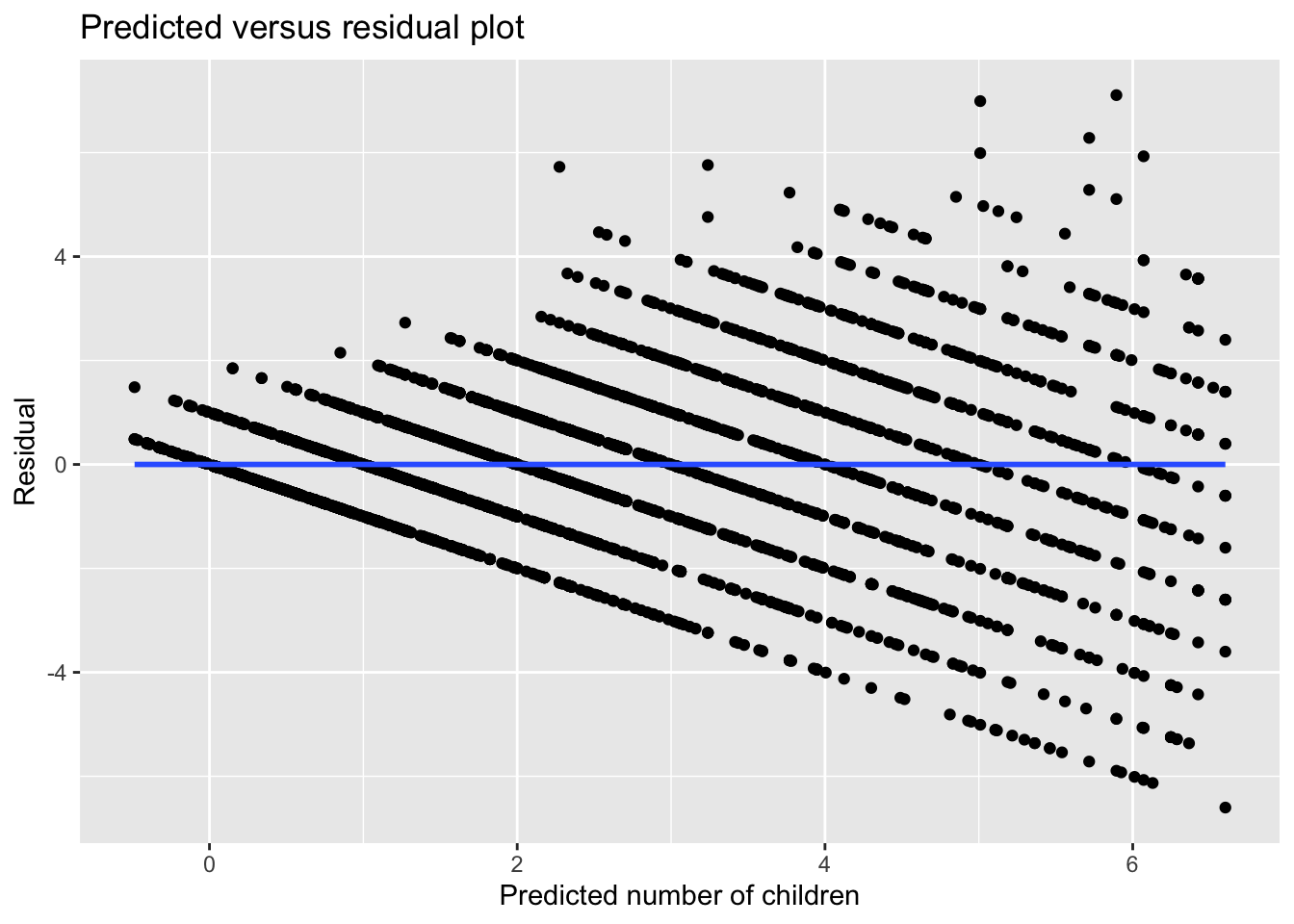
14.6.4 Q4. Verify that sample covariance between education and residuals = 0.
We’ll do the same here as we did with the fitted versus residuals. First, we’ll use R to calculate the covariance.
## [1] 1.216786e-15As with before, this number is not exactly zero, but it is basically zero.
We can confirm this with visual inspection.
ggplot() +
aes(x = dat$educ, y = fmod1$residuals) +
geom_point(position = "jitter") +
labs(x = "Education",
y = "Residual",
title = "Education versus residual plot") +
geom_smooth(method = "lm", se = FALSE)## `geom_smooth()` using formula = 'y ~ x'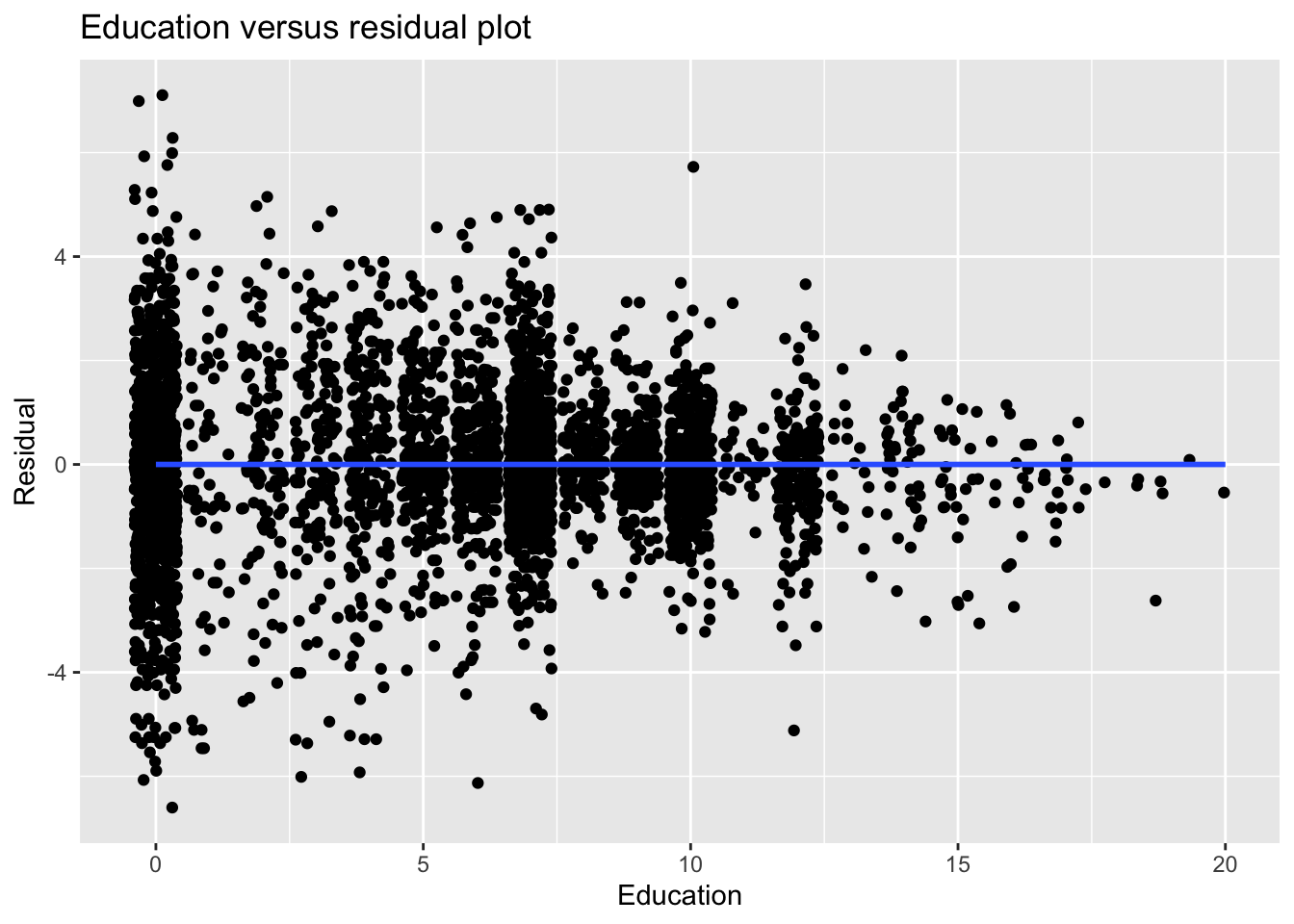
14.6.5 Q5. Re-estimate the regression equation of the number of children on education, age of the mother, and electricity but also include the square of the age of the mother. How do you now interpret the effect of age on the number of children?
Our population model is:
To include I(age^2)). This tells the lm() command to calculate whatever is inside I().
##
## Call:
## lm(formula = children ~ educ + age + I(age^2) + electric, data = dat)
##
## Residuals:
## Min 1Q Median 3Q Max
## -5.8576 -0.7153 -0.0005 0.7186 7.4868
##
## Coefficients:
## Estimate Std. Error t value Pr(>|t|)
## (Intercept) -4.2475679 0.2406003 -17.654 < 2e-16 ***
## educ -0.0788944 0.0062513 -12.620 < 2e-16 ***
## age 0.3370397 0.0165166 20.406 < 2e-16 ***
## I(age^2) -0.0026696 0.0002718 -9.822 < 2e-16 ***
## electric -0.3777901 0.0673176 -5.612 2.12e-08 ***
## ---
## Signif. codes: 0 '***' 0.001 '**' 0.01 '*' 0.05 '.' 0.1 ' ' 1
##
## Residual standard error: 1.455 on 4353 degrees of freedom
## Multiple R-squared: 0.5716, Adjusted R-squared: 0.5712
## F-statistic: 1452 on 4 and 4353 DF, p-value: < 2.2e-16Our model returns a regression equation of:
Adding the quadratic (i.e. squared) term for age to the model returns a positive coefficient for
You can check this result by using a graphing calculator app like Desmos (https://www.desmos.com/calculator) and entering a function that only includes the terms for
Using the ‘wage1’ datadest from ‘woolridge’ on US workers in 1976…
14.6.6 Q6. Estimate the regression equation of the hourly wage (
Our population model is:
library(wooldridge)
data("wage1")
wage_mod1<- lm(wage ~ educ + exper, data=wage1)
summary(wage_mod1)##
## Call:
## lm(formula = wage ~ educ + exper, data = wage1)
##
## Residuals:
## Min 1Q Median 3Q Max
## -5.5532 -1.9801 -0.7071 1.2030 15.8370
##
## Coefficients:
## Estimate Std. Error t value Pr(>|t|)
## (Intercept) -3.39054 0.76657 -4.423 1.18e-05 ***
## educ 0.64427 0.05381 11.974 < 2e-16 ***
## exper 0.07010 0.01098 6.385 3.78e-10 ***
## ---
## Signif. codes: 0 '***' 0.001 '**' 0.01 '*' 0.05 '.' 0.1 ' ' 1
##
## Residual standard error: 3.257 on 523 degrees of freedom
## Multiple R-squared: 0.2252, Adjusted R-squared: 0.2222
## F-statistic: 75.99 on 2 and 523 DF, p-value: < 2.2e-16Our model returns a regression equation of:
The terms are:
-
-
-
14.6.7 Q7. How do the coefficients change when the units of wages are in cents instead of dollars?
The coefficients would all be multiplied by 100 (i.e.
To confirm, let’s convert the
##
## Call:
## lm(formula = I(wage * 100) ~ educ + exper, data = wage1)
##
## Residuals:
## Min 1Q Median 3Q Max
## -555.32 -198.01 -70.71 120.30 1583.70
##
## Coefficients:
## Estimate Std. Error t value Pr(>|t|)
## (Intercept) -339.054 76.657 -4.423 1.18e-05 ***
## educ 64.427 5.381 11.974 < 2e-16 ***
## exper 7.010 1.098 6.385 3.78e-10 ***
## ---
## Signif. codes: 0 '***' 0.001 '**' 0.01 '*' 0.05 '.' 0.1 ' ' 1
##
## Residual standard error: 325.7 on 523 degrees of freedom
## Multiple R-squared: 0.2252, Adjusted R-squared: 0.2222
## F-statistic: 75.99 on 2 and 523 DF, p-value: < 2.2e-1614.6.8 Q8. Compare the estimated coefficient for education to the one obtained by regressing only the hourly wage on educaiton. Interpret.
This population model is:
##
## Call:
## lm(formula = wage ~ educ, data = wage1)
##
## Residuals:
## Min 1Q Median 3Q Max
## -5.3396 -2.1501 -0.9674 1.1921 16.6085
##
## Coefficients:
## Estimate Std. Error t value Pr(>|t|)
## (Intercept) -0.90485 0.68497 -1.321 0.187
## educ 0.54136 0.05325 10.167 <2e-16 ***
## ---
## Signif. codes: 0 '***' 0.001 '**' 0.01 '*' 0.05 '.' 0.1 ' ' 1
##
## Residual standard error: 3.378 on 524 degrees of freedom
## Multiple R-squared: 0.1648, Adjusted R-squared: 0.1632
## F-statistic: 103.4 on 1 and 524 DF, p-value: < 2.2e-16It returns a regression equation of:
In a simple bivariate model of
This shows that omitted variable bias does not always result in the overestimation of coefficients, but can also cause them to be underestimated.
Looking at the scatterplot
While we see a clump of points that have low levels of experience (purple) in the lower left-hand corner, most of the the purple point tend to be above the simple bivariate regression line, which means they are outperforming what we would expect what we would expect in the model that does not account of experience.
ggplot(wage1) +
aes(x=wage, y=educ, color=exper) +
geom_point(position="jitter") +
scale_color_viridis_c() +
geom_smooth(method = "lm", se = FALSE) +
labs(x="Education",
y="Wage",
color="Exper",
title="Wage by education") ## `geom_smooth()` using formula = 'y ~ x'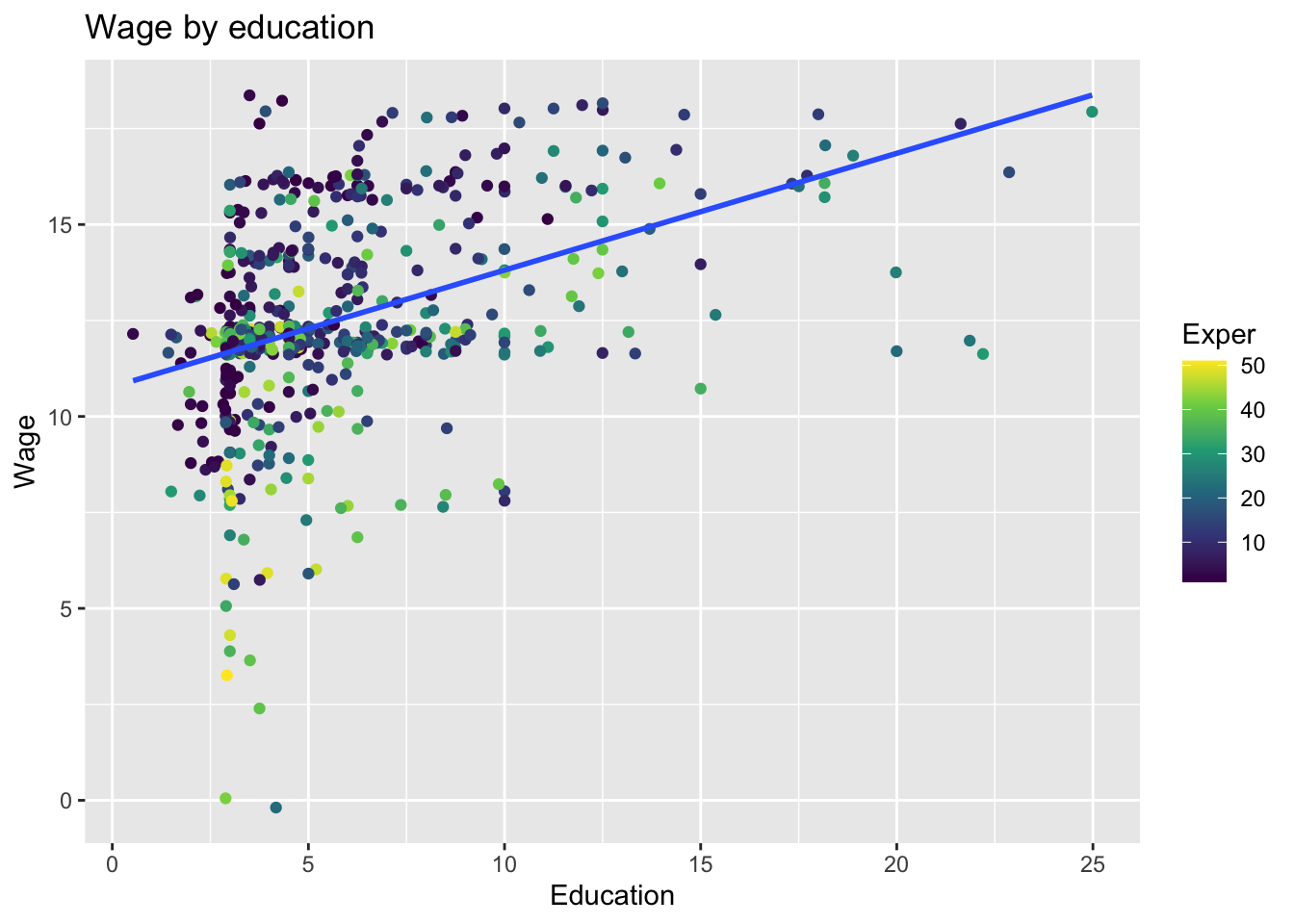
14.7 Additional practice questions
There’s an old saying (often attributed to Winston Churchill) that says, “If you are not a liberal when you are young, you have no heart. If you are not a conservative when you are old, you have no brain.” And, yet there have been activist left-wing groups comprised of seniors, like the Raging Grannies.
Using our sample CES dataset, explore the relationship between Canadians’ support for free market principles (
We’re going to run two regression models. Model 1 will regress
load("Sample_data/ces.rda")Before we begin, it’s useful to look at the univariate distributions of out variables. Besides letting us know of missing values, it also helps with interpreting the substantive significance of any relationships we find.
summary(ces$marketlib)## Min. 1st Qu. Median Mean 3rd Qu. Max. NA's
## 0.00 6.00 9.00 8.59 11.00 16.00 32684sd(ces$marketlib, na.rm = TRUE)## [1] 3.519915summary(ces$age)## Min. 1st Qu. Median Mean 3rd Qu. Max.
## 18.0 35.0 49.0 48.7 62.0 99.0sd(ces$age, na.rm = TRUE)## [1] 16.60883summary(ces$gender)## Man Woman NA's
## 15517 21928 288table(ces$gender) %>% prop.table()##
## Man Woman
## 0.4143944 0.5856056Market liberalism variable ranges from 0 to 16, with a mean of 8.59 (SD = 3.52). (Note: this is a simple additive index, or summated rating scale, of four Likert-type items that has been commonly used in Canadian political science research.)
Age ranges from 18 to 99, with a mean of 49.0 (SD = 16.61).
Gender is categorical variable, with about 58.6% being women and 41.4% being men.
14.7.1 1. For both Model 1 and Model 2, write the equation of the population models.
Our population models are:
14.7.2 2. Run the regressions and write out the equations for the estimated regression models.
##
## Call:
## lm(formula = marketlib ~ gender + age, data = ces)
##
## Residuals:
## Min 1Q Median 3Q Max
## -9.3775 -2.2386 0.2442 2.5586 8.2885
##
## Coefficients:
## Estimate Std. Error t value Pr(>|t|)
## (Intercept) 8.309741 0.195029 42.608 < 2e-16 ***
## genderWoman -0.855020 0.099390 -8.603 < 2e-16 ***
## age 0.013516 0.003192 4.234 2.34e-05 ***
## ---
## Signif. codes: 0 '***' 0.001 '**' 0.01 '*' 0.05 '.' 0.1 ' ' 1
##
## Residual standard error: 3.474 on 5022 degrees of freedom
## (32708 observations deleted due to missingness)
## Multiple R-squared: 0.02078, Adjusted R-squared: 0.02039
## F-statistic: 53.28 on 2 and 5022 DF, p-value: < 2.2e-16Our regression equation for Model 1 is:
##
## Call:
## lm(formula = marketlib ~ gender + age + I(age^2), data = ces)
##
## Residuals:
## Min 1Q Median 3Q Max
## -9.2733 -2.2700 0.4905 2.5909 8.9988
##
## Coefficients:
## Estimate Std. Error t value Pr(>|t|)
## (Intercept) 6.2610833 0.5002976 12.515 < 2e-16 ***
## genderWoman -0.8560525 0.0992055 -8.629 < 2e-16 ***
## age 0.0996610 0.0196397 5.074 4.03e-07 ***
## I(age^2) -0.0008238 0.0001853 -4.445 8.97e-06 ***
## ---
## Signif. codes: 0 '***' 0.001 '**' 0.01 '*' 0.05 '.' 0.1 ' ' 1
##
## Residual standard error: 3.467 on 5021 degrees of freedom
## (32708 observations deleted due to missingness)
## Multiple R-squared: 0.02461, Adjusted R-squared: 0.02403
## F-statistic: 42.24 on 3 and 5021 DF, p-value: < 2.2e-16Our regression equation for Model 2 is:
14.7.3 3. Explain what the coefficients mean in both models. How does the effect of age differ between Model 1 and Model 2?
Model 1, our coefficients are:
-
-
-
Model 2, our coefficients are:
-
-
-
14.7.4 4. Which of the models better explains the relationship between
The
Also, empirical performance isn’t everything. Fortunately, there are also theoretical reasons to suspect that the effect of age might not be a clear-cut linear relationship suggested by the old adage. Older folks typically have lower levels of income and tend to rely upon the welfare state more than younger folks (on average, and all other things being equal). So, life-cycle effects might cause their interests to change, and by extension, their orientations on how society ought to be run.
There is also the issue that comparing across ages at one point in time cannot separate life-cycle effects from generational effects, which neither of these models would be able to disentangle.